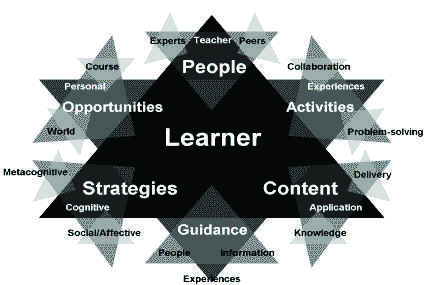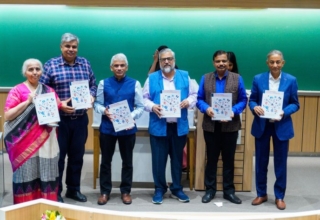
Dr Poonam Bhatia, Associate Professor – Bharti College, University of Delhi
The pandemic has forced universities to bring their courses online. This is just one-step along the road to a new educational paradigm; however we can expect a new model to emerge once COVID-19 has passed.

The pandemic that has shuttered economies around the world has also battered education systems in developing and developed countries. Some 1.5 billion students close to 90% of all primary, secondary and tertiary learners in the world are no longer able to physically go to school. The impact has been dramatic and transformative as educators scramble to put in place workable short-term solutions for remote teaching and learning, particularly in emerging markets, where students and schools face additional challenges related to financing and available infrastructure.
While each level of education faces its unique challenges, ,it is the higher education segment that may end up, by necessity, triggering a learning revolution. Universities are distinctive in that their students are both old enough to handle the rigours of online work and technologically savvy enough to navigate new platforms. The challenge lies for the institutions in which they have enrolled. Can traditional, campus-based universities adapt by choosing the right artificial intelligence-machine learning based technologies,pedagogue driven online content, community of experts, teachers/faculty and peers for sharing knowledge and solving your learning related problems andother community driven approaches for educating and engaging their students? The successes and failures that unfold should give us all a better grasp of what is possible.
Right now, video-conferencing apps like Zoom, Google class and WebEx are throwing universities a lifeline. However, lecturers are still struggling to maintain the same depth of engagement with students they could have in a classroom setting. They need to find solutions and fast to avoid a dip in the quality of education they are providing.
The adoption of technology based digital online learning solutions in recent months has been unprecedented. In the short term, educators are applying a ‘first aid’ solution by switching entirely from in-person to remote instruction, a move that has been forced upon them by sudden mandatory campus closures. But they are quickly realizing that remote technology based digital online learning is just a baby step experiments, in the long journey to offering digital online education that has been conceived as such, which includesartificial intelligence-machine learning based technologies, pedagogue driven online content, community of experts, teachers/faculty and peers for sharing knowledge and solving your learning related problems and other community driven approaches for educating and engaging their students. It requires creation of effective online student engagement tools and repurposing teacher training with elements of pedagogue driven online digital learning content creation, online evaluation and assessment of learning retention and remedial module/chapter wise ,mentoring, motivation and problem solving of students.
As painful and stressful a time as this is, it may fashion a long overdue and welcome rebirth of our education systems. The pandemic has been a great leveller in a way, giving all stakeholders (educators, learners, policy-makers and society) in developed and developing countries a better understanding of our current education systems’ vulnerabilities and shortcomings. It has underscored how indispensable it is for our populations to be digitally literate to function and progress in a world in which social distancing, greater digitalization of services and more digitally centred communications may increasingly become the norm. More fundamentally, pandemic is causing us to challenge deep-rooted notions of when, where, and how we deliver education, of the role of colleges and universities, the importance of lifelong learning, and the distinction we draw between traditional and non-traditional learners.
The Broken higher education online digital learning systems….
We will deliberate on only key four elements of broken higher education online digital learning systems
1-Pedagogue based digital online content
2-Repurosing the teachers/faculty
3- Creation of community of online learners, experts and teachers
4- Artificial intelligence and machine learning based technology for personalized learning
Element 1- Pedagogue based digital online content
Technology will be about the content, not the container.
“The fourth great age cataclysmic, paradigm-changing age in human history is now, with the internet. Anyone can think a thought, publish a thought, and it’s out there to the world.” Traditional institutions of higher education were founded on a proliferation of books, on the idea that knowledge was available through libraries and colleges if we could learn the road to access. Today, the road to access does not necessarily detour through the university, and anyone, of just about any age, can travel it.
But universities, and more importantly educators, still have a role to play in the production and circulation of information, in the cultivation of a digital citizenry. To fulfill that role indeed, in order to see it with any clarity at all they must begin to think differently about online learning. Education as a whole needs reassembling; but digital education borne thus far from a mimicry of on-ground learning needs immediate re-examination. Online learning is yet in its impressionable infancy, and can be moulded, grown, and led into a meaningful maturity.
It is possible to become so enamoured with the AI-ML-VR technology (and so distracted by device-related and delivery related questions) that insufficient attention is then given to how to use whatever devices are eventually deployed to their full effect. As we move to a greater proliferation of devices, combined with the fact that we will be accessing more content from multiple places, a greater value will be placed on the pedagogue driven content, and how that content is used, rather than on any one particular device. Viewed from this perspective, the future of education is in the ‘pedagogue driven content’, not the ‘container’.
The key failure of online digital learning has been its attempt to duplicate, replicate, or simply dump into an LMS the content and strategies of on-ground learning. We need to recognize that online learning uses a different platform, builds community in different ways, demands different pedagogies, has a different economy, functions at different scales, and requires different choices regarding curriculum than does on-ground education. Even where the same goal is desired, very different methods must be used to reach that goal.
Unless online teaching — and classroom teaching as well — begins to first, unscaffold learning problems and second, rediscover embodied pedagogy, we will obstruct learning rather than foster it. We will push students away from authentic learning experiences rather than draw them toward such experiences.” Because so many have been afraid that learning would not happen in online courses, we’ve focused on the machinations of technology to (en)force that learning. But in doing so, we’ve missed an opportunity to create unique learning experiences.
The machinations, which is referred to as “scaffolding”, have led to further obscenities, including the “learning object” and the canned and endlessly duplicated course. The former is an attempt to reduce learning to atomic building blocks — discussion topics, quizzes, flash-based interactive modules — swapped out like trading cards no matter the course or students. The latter is the all too common practice of teaching from a single “master” course, reused semester after semester by various faculty without substantive changes to the content.Online learning has been so involved with the facility of the technology that it has overlooked the complication of good pedagogy.
The invention of online learning and digital pedagogies should be driven by educators, not industry. Faculty expertise and experience are indispensable for selecting appropriate technologies for distance education.” There is this norm for technological decisions to be made at the administrative level, for online classes to be taught almost exclusively by contingent faculty, and for online curriculum to be designed by faculty with little-to-no expertise in digital pedagogy. We need to work to help the technological decision-makers at institutions of education understand that technology is a pedagogical decision — that the choices made around technology don’t drive pedagogy but are driven by careful decisions and thinking about teaching and learning.
Supporting innovative digital pedagogies means investing in robust inter- and intra-institutional collaborations, and it means hiring and creating a culture for the development of digital pedagogues. Institutions should not outsource online learning to Coursera, or the like, as a substitute for developing internal expertise in and discussion about online learning. What we need is to gather together experts in digital pedagogy willing to turn their attention toward solving the problem of online learning, toward innovating new methodologies, and toward rebuilding what we value most about education in digital space. And, if we are going to successfully automate any bit of the work of teaching and learning, we must make our machine relationships altogether more intimate. Our algorithms are not sufficiently complex to capture the dynamic, sometimes poetic, nature of learning.
Element 2- Repurposing the teacher /faculty.
Stop worrying whether online learning will usurp traditional education.
More and more college faculty
are worried over predation by online
learning. Many higher education teachers/faculty are concerned online courses,
especially massive ones, will automate their jobs, making them and their very
human teaching methods obsolete. Additionally, teachers/faculty fear that MOOCs, led by celebrity
instructors, will further reduce attendance in their on-ground and even hybrid
classrooms, and they worry they’re being made to compete with digital
pedagogies they have no training and/or interest in.
Teaching versus learning, will need figuring.
Oscar Wilde once said, “Education is an admirable thing, but it is well to remember from time to time that nothing that is worth learning can be taught”. Going forward, the role of the teacher will get redefined. The notion of a teacher or an educator as the knowledge-holder who imparts wisdom to pupils is no longer fit for the purpose of the future. With students being able to gain access to knowledge, and even learn many a technical skill, through a few clicks on their phones, tablets and computers, we will need to redefine the role of the teacher in the classroom of tomorrow. This may mean that the role of teachers will need to move towards facilitating young people’s development as contributing (and employable) members of society, rather than just lecturing.
An education process that pushes students to the center changes the teacher’s/faculty role to one of facilitator, guide, and coach. It places emphasis on students as active participants in the process of finding, organizing, analyzing, and applying information in novel ways to solve problems. Students become part of a learning community where they collaborate to discover information from a variety of sources, including peers, teachers, experts, real-world data, simulations, and experiences. Ultimately, they apply that information in novel ways to solve problems, communicate ideas, and continuously add to their knowledge base.
In response to this external pressure, teachers/faculty have recently jumped on a cooperative- or active-learning bandwagon. Based on research, this popular approach offers cooperative activities such as “think-pair-share” and “jigsaw” techniques as a means of placing students in the center of the learning process. However, this methodology ignores the needs of receptive, analytic, linear learners who may be disadvantaged by an active approach.A single approach will not suffice and that teachers must be well versed in current research from cognition and learning theory in order to understand how learning occurs and to create their own, eclectic techniques. It falls upon the teacher to constantly recreate the instructional process and offer a variety of choices for approaching information and tasks in order to meet learners’ ever-changing, individual needs.

Key to the success of approach to faculty education is to provide teachers/faculty with skills and expert tools that ultimately lead to their independence as learner-centred curriculum designers. The faculty education program should progresses from awareness of our current understanding of learning and assessment, online digital pedagogue curriculum design, online instructional techniques as part of development process. Finally, teachers/faculty should be made highly proficient in learning outcomes, new evaluation and learning rewards procedures.
The teacher/faculty development institutes should also teach curriculum innovation, to chosen few faculty, who then enter into a live planning and design online digital learning process with the teams of specialists in learning and assessment theory, instructional techniques and learning procedures, curriculum design, visualization, knowledge management, programming, and video distribution . The live project based meetings between experts and the faculty is to enable faculty with existing models and help them combine content with learning objects and desired performance outcomes.
Element 3– Creation of community of online learners,peers, experts and teachers/faculty.
The businessesuntil 50 years ago were controlled by Governments through various rules and regulations; in India it was called Licence Raj/inspector Raj. Post 1991 in India in the 1960 and 70s in USA ,Europe , japan , Australia etc businesses became competitive with introduction of new technologies, design features, lower price points which led to proliferation of high quality companies across sectors of industry worldwide. Markets became the entity, which rewarded corporations on the quality of products/services, innovations, price differentials etc
Movies are part of great entertainment industry worldwide. It is backed up by great studios, movie directors, actors, distribution network online and offline. The 135 years old movie industry today is worth $ 78 billion, compare it with 10 year old online gaming industry which is worth $ 190 billion .Online gaming industry is driven by community of gamers, Facebook /what’s app/Instagram/LinkedIn are communities which specific purposes .Virtual digital communities are the most important the Third pillar of business.
The future of digital online higher education and learning will also be governed by the third pillar”’ online community”’ of peers, experts, faculty, experts and mentors.
It’s a well-known fact that when communities band together they achieve far greater things than they would have individually. Building online learning communities is one way to motivate learners to accomplish much more than what traditional learning environments can achieve.
Why Do You Need An Online Learning Community?
It takes a group of individuals, working together, to accomplish their individual goals.
1) For most learners, learning is a “group thing”
When someone in the group finds a particular concept or theory especially challenging to grasp, a fellow learner will quickly step in to lend their support.
2) Communities inspire
Individual participants often get inspiration from their colleagues, causing the individual to “up their own game”. Shared online learning community values provide opportunities to inspire and motivate even the weakest learners in the group to improve their performance.
3) Learning transcends learning hours
Most active learners continue the process of learning well beyond regular learning hours. As a social learning forum, an online learning community provides individuals opportunities to continue their learning beyond regulated business or learning schedules.
4) Learning needs stimulus and engagement
While scheduled classroom time, or formal online learning routines are great, many learners need to engage with fellow learners beyond those opportunities. Creating a like-minded community of learners online provides greater freedom to engage and further the cause of learning.
How To Build An Online Community
Contrary to what we may have read or heard about online communities, they don’t “just run by themselves!”. To do it right requires thought, planning and managed execution. The more thought that goes into creating your community, the more effective it will be in meeting the learning objectives you set out for the community.
1) Understand learners’ needs
The internet is already filled with forums and platforms where people can come together to socialize. Creating yet another one under the guise of “learning” may not be such a great idea after all. To be effective, online learning community must cater to specific needs of the learners. Use online surveys or polling questions to find out what it is that your learners are looking for before planning and building the solution.
2) Choosing the right platform
Once one understands learner needsthe need to use that information to choose the right vehicle around which to build the community. For instance, a group of professionals that is not very active on Facebook may prefer learning via social platforms like LinkedIn. Others may lean towards blogs or chat forums.
3) Policing the community
Regardless of how mature or responsible learners may be, all it takes is a handful of “irresponsible” to thwart the goals of the community.Before launching the community, make sure one thinks about how one will monitor and administer learners. Too much policing will discourage open debate and stifle creativity; too little will frustrate and discourage serious learners. Therefore, it is important to strike a balance when creating your “Terms of Use” and “Community Rules”.
4) Creating the environment
Good moderation is essential if online learning community is to be a success. Moderators should aim to encourage full member participation. For instance, make new members feel welcome; encourage long-time members to lend their support (or voice) on specific matters; offer constructive thoughts or critique on topics being discussed.
5) Make it a learning resource
Successful online communities are those
that members find useful as the “go to” place to further their learning. When
individual members need access to specific information or resources to help
with their learning challenges, community should be where they turn to first!
As one buildslearners community, one must
think about creating repositories and archives of invaluable resources that
members can access to learn more about a specific topic or subject
being discussed. Where possible, arrange for Subject Matter Experts (SMEs) to
be available to the community to help them further their learning.
6) Be image conscious
While your online learning community is meant to serve as an “informal” gathering of like-minded learners, remember one essential point: It is still part of the learning experience. As such, whatever transpires within those communities has a direct reflection on values.
While fostering and encouraging healthy communication between members in such online communities of learning, always make sure that the institutions image and messaging is not tarnished or put in disrepute.
7) Be engaged
As has already been mentioned above, online communities don’t just run by themselves. To make them successful, one need to be engaged every step of the way. Know what members need; understand how their expectations are changing; be available online frequently, so that members can raise their concerns about the community, discuss ideas about improving it, or simply ask for assistance when needed.
Success is a “community thing”
Some learning communities start out with a bang, but quickly fizzle out due to lack of membership response. The trick to making an online learning community survive and thrive is to create a formula where the membership – NOT the moderators – drives what the community looks like, and how it runs.
Communities that are not engaged will not stay together for too long. To keep the community involved, you could institute a system of merit badges (Expert, Guru, Novice, Rookie of the Month), points (5-stars, 3-stars etc.) or membership grades (Gold, Silver, Platinum) to recognize and encourage community participation. Schemes like “Post of the Week” or “Blog of the Month” will also foster greater community participation.
It is also essential that the online learning community you create does not evolve into a behemoth that becomes hard to manage or “tame”. To avoid this eventuality, experts recommend that you think about creating “communities within communities
Element 4- Artificial intelligence and machine learning based technology for personalized learning.
Artificial intelligence (AI) is rapidly transforming and improving the ways that industries like healthcare, banking, energy, and retail operate. However, there is one industry in particular that offers incredible potential for the application of AI technologies: education. The opportunities — and challenges — that the introduction of artificial intelligence could bring to higher education are significant.
Personalized learning as a cornerstone
Today’s colleges and universities face a wide range of challenges, including disengaged students, high dropout rates, and the ineffectiveness of a traditional “one-size-fits-all” approach to education. But when big data analytics and artificial intelligence are used correctly, personalized learning experiences can be created, which may in turn help to resolve some of these challenges.
With a personalized learning experience, every student would enjoy a completely unique educational approach that’s fully tailored to his or her individual abilities and needs. This could directly increase students’ motivation and reduce their likelihood of dropping out. It could also offer professors a better understanding of each student’s learning process, which could enable them to teach more effectively. AI-based learning systems would be able to give professors useful information about their students’ learning styles, abilities, and progress, and providesuggestions for how to customize their teaching methods to students’ individual needs. For example, some students might be experiencing learning difficulties or challenges that require extra attention or tutoring to keep up. Others might be advancing so rapidly that they are not being intellectually challenged and would benefit from additional study materials or assignments. In both of these hypothetical scenarios, AI learning systems would be helping students to reach their full potential, quite possibly preventing them from dropping out by identifying problems early enough to allow the appropriate corrective measures to be taken.
Personal data will be a key ingredient
In theory, the application of AI and personalized learning sounds like an ideal solution to some of the most common educational issues. However, the technology still has a long way for to go before it can fully meet its potential.
The primary ingredient of personalized learning is a large amount of student data. Today students are more protective of the privacy of their data than previous generations, most likely due to the security breaches and data scandals they have already been exposed to. However, if student data could be collected and processed in a way that was ethical, secure, and transparent, it would allow AI to be used to effectively improve just about every area of study.
It is essential that students understand that over time, more repetitive and routine tasks will be automated and performed by artificial intelligence, automation, and robots. However, there will always be roles requiring creative skills, cognitive skills, and emotional intelligence skills. Right now, many universities around the world are failing to teach students about the kinds of skills that will and will not be needed in their future careers.
As artificial intelligence is applied to education, the best results will come from combining the strengths of AI and human abilities. There will never be a time when humans are not necessary for the tasks related to education. For example, teachers will always play a crucial role in our society, as we must never underestimate the value of human interaction and critical thinking in the field of education.
AI-based learning systems would be excellent tools for teaching rule-based subjects like foreign languages, science, technology and maths. AI systems could significantly enhance the learning process by providing greater precision and more accurate feedback, and would also allow students to take the time to repeat study exercises as many times as necessary. However, a teacher would still be needed to help explain whatever students do not understand, like the nuances and exceptions to rules of languages, or how to apply physics, chemistry, mathematical formulas to solve problems. The professor’s role would be to guide, support, and mentor students, helping them to understand what they have learned, why it’s important, and how it can be applied in the real world.










